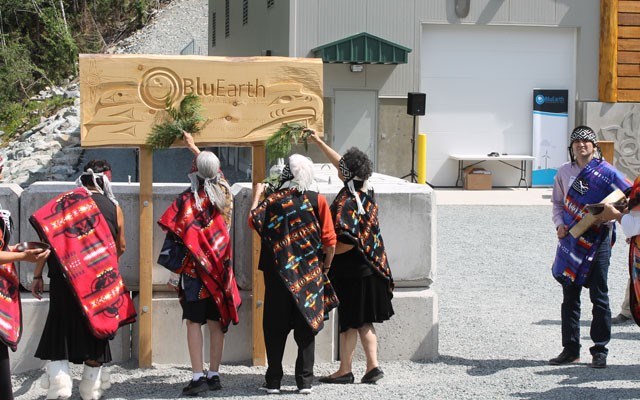From a process that began more than a decade ago, the completion of the Culliton Creek Hydro Facility was celebrated with a traditional potlatch ceremony on Wednesday, May 25.
The IPP (Independent Power Producer) site is a run-of-river partnership between BluEarth Renewables, the Squamish Nation and the Tsleil-Waututh Nation that will produce up to 15 megawatts of electricity, enough to power almost 6,000 homes.
In a commissioning ceremony that included Squamish Nation members, women used cedar boughs dipped in water to wipe a large wooden sign near the entrance to the powerhouse.
"We want to share our blessing," said Squamish Councillor Joshua Joseph. "Our water is like holy water — the idea is to brush off negative thoughts."
The Culliton project is relatively small — the intake is three kilometres above the powerhouse site, which is about 800 metres above and visible from Highway 99. The powerhouse is decorated with massive metal sculptures by Squamish Nation artist Xwalacktun (Rick Harry) of the sun and an eagle, along with a carving of a salmon and a traditional long house structure.
BluEarth in 2013 took over the Culliton contract from Pamawed Resources, which initiated discussions and planning back in 2002. Once the project began, a total of about 200,000 worker hours were logged by 80 on-site workers during peak construction, with 13 per cent of those from Squamish Nation.
Chief Bill Williams said this is the Nation's ninth IPP and he welcomes such projects, as long as they are not undertaken in culturally sensitive areas.
"I'm familiar with every square inch of our territory," he said, adding that in order for BluEarth to construct the intake, they had to blast through walls of rock in a heavily forested area that barely had a trail through it. "There was sort of a logging road that went part way up."
John Rustad, Minister of Aboriginal Relations & Reconciliation, on hand for ceremony, noted that there are currently 41 revenue-sharing projects with 34 First Nations in B.C. "This is an example of the type of partnerships... that will provide long-term economic benefits to the Nation."
BC Hydro spokesperson Mora Scott said a call for small run-of-river projects — those of 15 megawatts or less — will remain open. Currently, there are more than 100 electricity purchase agreements in place, and about 20 more developments under consideration.
"IPPs are preferred," she said. "They're smaller and they complement our hydro generating and our big dams," she said. IPPs also include wind, water, solar and biomass projects.
"Based on our current load forecast and expected demand... we forecast how much we need, in the coming years we're not expecting to need any (larger) IPP projects," she said, adding that IPPs contribute about one-quarter of the electricity that Hydro generates.




